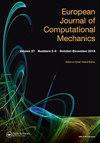An Differential Quadrature Finite Element and the Differential Quadrature Hierarchical Finite Element Methods for the Dynamics Analysis of on Board Shaft
IF 0.6
Q3 MECHANICS
引用次数: 6
Abstract
In this paper the dynamic analysis of a shaft rotor whose support is mobile is studied. For the calculation of kinetic energy and stiffness energy, the beam theory of Euler Bernoulli was used, and the matrices of elements and systems are developed using two methods derived from the differential quadrature method (DQM). The first method is the Differential Quadrature Finite Element Method (DQFEM) systematically, as a combination of the Differential Quadrature Method (DQM) and the Standard Finite Element Method (FEM), which has a reduced computational cost for problems in dynamics. The second method is the Differential Quadrature Hierarchical Finite Element Method (DQHFEM) which is used by expressing the matrices of the hierarchical finite element method in a similar form to that of the Differential Quadrature Finite Element Method and introducing an interpolation basis on the element boundary of the hierarchical finite element method. The discretization element used for both methods is a three-dimensional beam element. In the differential quadrature finite element method (DQFEM), the mass, gyroscopic and stiffness matrices are simply calculated using the weighting coefficient matrices given by the differential quadrature (DQ) and Gauss-Lobatto quadrature rules. The sampling points are determined by the Gauss-Lobatto node method. In the Differential Quadrature Hierarchical Finite Element Method (DQHFEM) the same approaches were used, and the cubic Hermite shape functions and the special Legendre polynomial Rodrigues shape polynomial were added. The assembly of the matrices for both methods (DQFEM and DQHFEM) is similar to that of the classical finite element method. The results of the calculation are validated with the h- and hp finite element methods and also with the literature.船载轴动力学分析的微分正交有限元及微分正交分层有限元方法
本文研究了支承为活动支承的轴转子的动力学分析问题。对于动能和刚度能量的计算,采用欧拉-伯努利梁理论,并采用微分正交法(DQM)导出的两种方法建立了单元和系统矩阵。第一种方法是微分正交有限元法(DQFEM),它是微分正交法(DQM)和标准有限元法(FEM)的有机结合,降低了动力学问题的计算成本。第二种方法是微分正交分层有限元法(DQHFEM),该方法是将分层有限元法的矩阵用与微分正交有限元法类似的形式表示,并在分层有限元法的单元边界上引入插值基础。两种方法所用的离散化单元都是三维梁单元。在微分正交有限元法(DQFEM)中,质量矩阵、陀螺矩阵和刚度矩阵是用微分正交(DQ)规则和高斯-洛巴托正交规则给出的权重系数矩阵进行简单计算的。采样点由高斯-洛巴托节点法确定。在微分正交分层有限元法(DQHFEM)中采用了相同的方法,并增加了三次Hermite形状函数和特殊的Legendre多项式Rodrigues形状多项式。两种方法(DQFEM和DQHFEM)的矩阵装配与经典有限元方法相似。用h-有限元法和hp有限元法以及文献对计算结果进行了验证。
本文章由计算机程序翻译,如有差异,请以英文原文为准。
求助全文
约1分钟内获得全文
求助全文

 求助内容:
求助内容: 应助结果提醒方式:
应助结果提醒方式:


